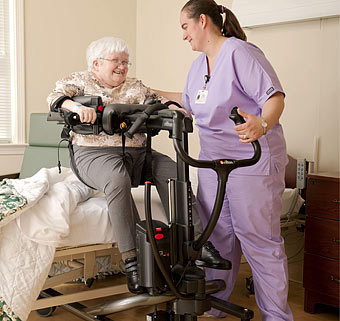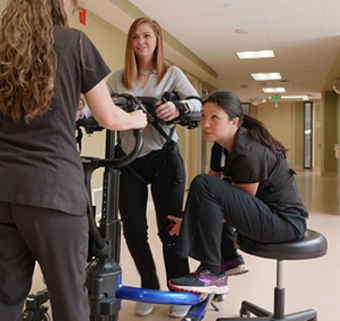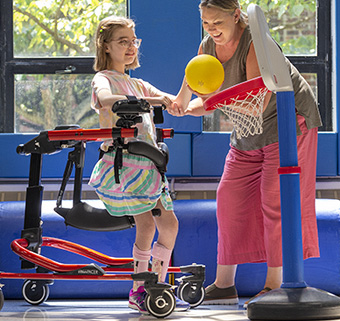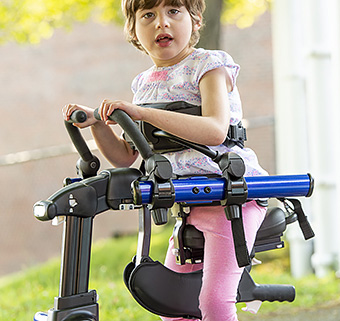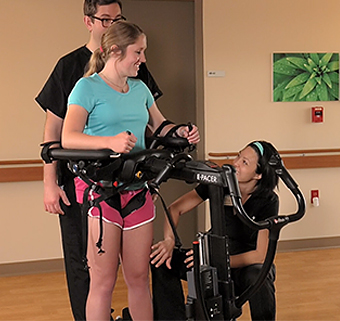Safe Patient Handling and Movement: Using Gait Training Equipment Safely for Best Outcomes
| August 2013It is an exciting time in the field of rehabilitation. For people who have sustained a neurological injury such as a stroke, incomplete spinal cord injury or traumatic brain injury there is now hope for regaining the ability to ambulate and sometimes even achieving a full recovery. In the past, a neurological injury was viewed as irreversible, and rehabilitation was focused on helping patients adapt and compensate, particularly if they showed no functional improvement a few weeks after the injury. Now we know that partial or full recovery is possible and can be achieved even many months following injury provided that rehabilitation is aggressive and immediate (1). While this requires hours and hours of hard work and intensive active practice by patient and therapist, this kind of focused rehabilitation is the key to remarkable outcomes that are being seen months or even years after the initial injury (1).
 Rehabilitation science now strongly emphasizes early intensive and repetitive practice for recovery of function in neurologically impaired individuals (2,3). Neuroscience research shows that the human brain and nervous system are not permanently damaged by injury. Remarkably, the central nervous system can create new neuronal branches to connect with other neurons to build new pathways in the brain. The brain’s ability to reorganize by forming new neural connections is known as neuroplasticity. This rewiring of the brain can occur after an injury or trauma if there is active purposeful movement of the affected limbs (4,5).
Rehabilitation science now strongly emphasizes early intensive and repetitive practice for recovery of function in neurologically impaired individuals (2,3). Neuroscience research shows that the human brain and nervous system are not permanently damaged by injury. Remarkably, the central nervous system can create new neuronal branches to connect with other neurons to build new pathways in the brain. The brain’s ability to reorganize by forming new neural connections is known as neuroplasticity. This rewiring of the brain can occur after an injury or trauma if there is active purposeful movement of the affected limbs (4,5).
Extended periods of physical inactivity after a neurological injury leads to the deterioration of bone and muscle strength, but also negatively affects neural circuits in what is termed “learned non-use.” Learned non-use occurs when the neural circuits shut down, thus blocking the formation of new neuronal pathways and connections which is the basis of neuroplasticity (6).
In contrast, using intense activity-based therapies soon after injury stimulates neural activity and promotes neural regeneration for improved recovery. Clearly, timing is an issue and the sooner active practice can begin the better.
In addition, with intensive and repetitive practice, the function of the central pattern generators (CPGs) is stimulated. CPGs are networks of spinal neurons distributed throughout the lower spinal cord regions. These relatively small, autonomous neural networks, when triggered, generate rhythmic stepping motions of the legs without dependency on the entire nervous system and sensory input from the limbs. Providing opportunities for repetitive step-taking after an injury in supported ambulation postures can stimulate the firing of the CPGs to further the recovery of walking (7,8).
Because the brain is neuroplastic and responds to repetitive and intensive therapy, we must give the patient sufficient practice opportunities. Often having the chance to perform thousands of repetitions and practice trials is the key to success. Adding a degree of challenge to the skill being practiced is also important for recovery as this demands focused attention and problem solving skills which additionally stimulate the brain. Intensity and challenge in gait training can be provided in the following ways:
- Duration – increasing length of practice sessions.
- Speed – increasing stepping pace.
- Balance – allowing opportunities for self-correction of unintended movements (patient loses balance in a safe and controlled situation and self-corrects to achieve improved gait quality).
- Resistance – adding weight, resistance, or “drag” while gait training.
- Accuracy – challenging stride length and limb placement during step taking (for example, navigating through a cone set up or over obstacles)
How can this intense and repetitive practice be safely incorporated in rehabilitation gait training? Certainly, a patient who has recently undergone injury, trauma or surgery is likely to fatigue quickly secondary to deconditioning, weakness, paralysis or lack of motor control. Most movements and activities require significant energy and concentration to complete. So ambulating for recovery can be a physically tiring process for both the therapist and the patient. Typically, the exercise session has to be cut short due to patient and therapist fatigue and to prevent the risk of patient falls or therapist injury. Because of this, utilizing equipment and applying the concept of safe patient handling and movement to the field of rehabilitation can be a significant solution.
In the past few decades, various body weight support devices, both over treadmill and over ground, have been designed to support ambulation practice. In a body weight support system, the patient’s feet are in contact with the ground, yet a percentage of their body weight is supported. With some of the load taken off their limbs, the patient can use their available strength to perform a walking pattern. Meanwhile, the therapist can focus with the patient on the quality of gait, rather than spending energy maintaining the patient’s upright position to prevent a fall. As a result, the patient is able to engage in more repetitions of the gait cycle before fatiguing
Manon LaBreche, PT, is the Injury Prevention Coordinator for Tampa General Hospital in Florida. LaBreche advocates the use of equipment for therapist safety. She notes that without supportive equipment, in the years before safe patient handling was an area of focus (the “caveman years” as LaBreche refers to them (9), gait training dependent patients could involve up to four PTs: two to hold the patient up and two to move the legs. “A PT will do whatever it takes to get a patient out of bed, even if it requires five personnel,” LaBreche comments. “We need to ask if the patient gains anything functionally through this, particularly if they are unable to participate. Equipment can provide the needed power and support so that patients can be mobilized.”
Safe patient handling and mobility as a clinical practice area was originally developed for nurses but is now impacting other health care personnel, including therapists. Therapists throughout the US are recognizing both the opportunity and the necessity of using the wide variety of SPHM devices available (10). By using safe patient handling equipment, supported transfer and ambulation can begin earlier during recovery. Early physical activity improves flexibility, reduces spasticity, and enables a patient to rediscover residual muscle strength, make strength gains and receive feedback on gait performance. There is also the additional benefit of decreased risk of pressure ulcers and urinary tract infections. Additionally, being upright provides the opportunity to relearn basic static balance and then move towards more complex dynamic balance control. Margaret Arnold, PT, the Safe Patient Handling coordinator of McLaren Bay Region in Bay City, Michigan relates this early recovery activity to motor learning and error augmentation:
“Motor learning is learning a new motor skill. In the case of brain injury, this may be re-learning a skill that was lost through injury, such as the ability to walk. Adaptive motor learning occurs most successfully through patient activation of muscle activity and error augmentation. The patient makes errors, learns from that, and corrects the movement. Robotic devices have been found to be effective in achieving high repetitions of movements for patients, which is important. However, over ground devices for gait training can provide an additional advantage, in terms of the opportunity for error augmentation and motor learning. Over ground devices require the patient to propel themselves forward unlike on a treadmill where they must simply pick their foot up.”
What Arnold brings up is a long standing question in rehabilitation. What is more effective in recovering ambulatory ability, over-ground gait practice or body weight supported treadmill training? This table offers a comparison between partial body-weight supported treadmill training, and body weight supported over ground training. Both can play a significant role in rehabilitation. Over ground gait training can serve as an important progression after treadmill training, to prepare a patient for community ambulation.
| PBWS Treadmill Training (TT) | BWS Over Ground (OG) |
| Amount of body weight that is off-weighted is pre-determined prior to initiation of gait practice | Amount of body weight that is off-weighted is determined during gait practice – the patient weight bears to maximum capability |
| Stride length and speed is determined by controlling the treadmill belt | Stride length and speed can be varied throughout the gait practice session by therapist and patient control of OG device |
| Environment is static or unchanging; patient’s visual field remains the same | Patient navigates through the environment; patient’s visual field correlates with normal, functional walking |
| Gait cycle and muscle activation is stimulated by movement of the treadmill belt | Gait cycle and muscle activation involves ground reaction forces and weight shifting of limbs resulting in sensation through feet that correlates with normal, functional walking |
| Direction of movement and gait cycle is repetitive and consistent | The option of directionality and motor planning by gait training through different routes in the environment promotes movement variability (10) |
| Indoor gait practice opportunity in same location | Environmental challenges can be varied; gait practice can occur outdoors on level surfaces, providing a stimulating and enriched environment |
| Gait practice occurs over treadmill with trained clinician during scheduled sessions | Gait practice opportunity can occur in between clinic sessions, during activities of daily living, at home with family members |
But regardless whether you are using treadmill training or over-ground practice, you need reliable SPH equipment, both for your safety and your patient’s. Sometimes this will mean letting go of our long-standing practice patterns of manual support and rehabilitation techniques and looking to the direction current evidence is pointing.
“I believe there is a cascade of barriers in knowledge and practices,” says Anna K. Steadman, MA, OTR, CHSP. Anna is owner of Essential Ergonomics, LLC in Kyle, Texas, a SPHM consultant firm. “I’m sure that in the future, cutting-edge SPHM practical education and training will be made a requirement at the academic level. In addition, CE and CEU educational entities will begin to mandate SPHM standards for healthcare professionals.”
Although still emerging, highly specialized SPHM equipment is becoming more available for gait rehabilitation purposes. One such device is the Rifton TRAM (transfer and mobility device). The Rifton TRAM is an over ground device that offers an innovative way to transfer patients and provide supported gait training. The TRAM offers safety and security while patients gain endurance and confidence in walking. By giving patients more opportunity to be upright and mobile, the TRAM can promote improved outcomes in functional mobility.
References
1. Sean Carter Walks Again: A Journey Through Traumatic Brain Injury Rehabilitation. Accessed June 2025. https://www.rifton.com/education-center/articles/sean-walks-again-video-part-1
2. Callahan J, Parlman K, Beninato M, Townsend E. (2006) Perspective: impact of the IIISTEP conference on clinical practice. J Neurol Phys Ther 30(3):157-66. Abstract
3. Behrman AL, Bowden MG, Nair PM. (2006) Neuroplasticity after spinal cord injury and training: An emerging paradigm shift in rehabilitation and walking recovery. Phys Ther 86(10):1406-25 Abstract
4. Nudo RJ (2006) Plasticity. NeuroRx 3(4):420-7. Abstract
5. Nelles G. (2004) Cortical reorganization – effects of intensive therapy. Restor Neurol Neurosci. 22(3-5):239-44. Abstract
6. Tansey KE, Jones M. (2009) Make Way for Change: Advances in neuroscience offer promise, along with challenges, for SCI rehab. Advance for Physical Therapy and Rehab Medicine 18(5).
7. Molinari M. (2009) Plasticity properties of CPG circuits in humans: impact on gait recovery. Brain Res Bull 78(1):22-5. doi: 10.1016/j.brainresbull.2008.02.030. Epub 2008 Mar 14. Abstract
8. Ivanenko YP, Poppele RE, Lacquaniti F. (2009) Distributed neural networks for controlling human locomotion: lessons from normal and SCI subjects. Brain Res Bull 78(1):13-21. doi: 10.1016/j.brainresbull.2008.03.018. Epub 2008 Apr 23. Abstract
9. Dilulio R. Patient Transfer Equipment. Physical Therapy Products. Accessed July 2013 http://www.ptproductsonline.com/all-news/15463-patient-transfer-equipment
10. Zinnecker-Hoener L. (2007) Safe Patient Movement for Therapists. Rehab Management. Accessed July 2013 http://www.rehabpub.com/2007/07/safe-patient-movement-for-therapists/


